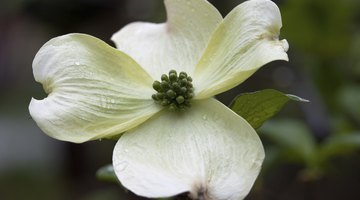Dogwood Vs. Redbud
Table of Contents
For limited-space gardens, both dogwood (Cornus spp.) and redbud (Cercis spp.) are good candidates. Rarely do either of these trees rise above 30 feet tall. Both dogwood and redbud give showy spring blooms, and they complement each other in flower color -- white for dogwood and pink for redbud -- and growth form.

Both kinds of plants have multiseason interest and are deciduous. You can grow both dogwood and redbud together for an impressive spring floral display or grow them separately as specimens.
Kinds of Dogwood
Dogwoods are mostly small trees or shrubs, with about 17 species native to the United States. Flowering dogwood (Cornus florida), hardy to U.S. Department of Agriculture plant hardiness zones 5 through 9, is probably the widest grown, with many varieties. Blooms are mostly white, but some cultivars have pink or red flowers. Native to Japan and Korea, Kousa dogwood (Cornus kousa) has summer-blooming white flowers and is hardy in USDA zones 5 through 8. A West Coast native, white-flowered Pacific dogwood (Cornus nuttallii) grows in USDA zones 6b through 9a, with possible late-summer bloom following spring flowering.
Kinds of Redbud
About four species of redbud grow in gardens, with cultivars for each species. Most redbuds have flowers in various shades of pink, but white-flowered varieties exist. Perhaps most common is Eastern redbud (Cercis canadensis), hardy in USDA zones 4b through 9a. Varieties include trees with double flowers, purple leaves and variegated foliage. Other species include Western redbud (Cercis occidentalis, hardy in USDA zones 6 through 9), Chinese redbud (Cercis chinensis, hardy in USDA zones 6 through 8) and Judas tree (Cercis siliquastrum, hardy in USDA zones 6 through 9).
Size and Form
Redbud tends to grow as a multitrunked tree, but they can be shaped into a single-trunked specimen. Eastern redbud reaches 20 to 30 feet tall and 15 to 25 feet wide, while Western redbud is usually 15 feet tall and 10 feet wide. Many species of dogwoods grow as medium to small bushes, but flowering dogwood reaches 15 to 30 feet tall and as wide. Grow it as either a single- or multitrunked tree or as a large shrub.
Flower Characteristics
Redbud flowers are shaped like miniature sweet pea flowers. They come out on the branches, and sometimes even the trunk, before the leaves emerge. In contrast, dogwood's true flowers are inconspicuous and centered in the middle of showy, petal-like bracts. The papery bracts are long-lasting, with four bracts in flowering dogwood in Kousa dogwood and six in Western dogwood. Eastern dogwood blooms in midspring as the leaf buds are unfurling. Kousa dogwood blooms after leaves emerge, and Western dogwood's flowers appear in spring, with possible late summer rebloom.
Leaf Information
Both dogwoods and redbuds have sufficient foliage and canopy spread to serve as small shade trees. Dogwoods have oval, pointed leaves, and redbuds have heart-shaped to rounded leaves that may be purple to red on new growth. Dogwood often has colorful autumn foliage, with flowering dogwood leaves turning dark red. Redbud fall leaves are usually yellow.
Fruit Formation
Both dogwoods and redbuds provide fall color with their fruits. Dogwood has rounded fruits that follow the small true flowers. Flowering dogwood produces bright red fruits in late summer that attract songbirds and other wildlife. If not eaten, the fruits can stay on the tree after leaves fall. Redbud fruits are flattened pods that begin green but turn to brown or purplish-brown with maturity. They remain into the winter.
The Drip Cap
- For limited-space gardens, both dogwood (Cornus spp.) Rarely do either of these trees rise above 30 feet tall.
- Both kinds of plants have multiseason interest and are deciduous.
- A West Coast native, white-flowered Pacific dogwood (Cornus nuttallii) grows in USDA zones 6b through 9a, with possible late-summer bloom following spring flowering.
- Redbud tends to grow as a multitrunked tree, but they can be shaped into a single-trunked specimen.
- Redbud flowers are shaped like miniature sweet pea flowers.
- They come out on the branches, and sometimes even the trunk, before the leaves emerge.
- Dogwood often has colorful autumn foliage, with flowering dogwood leaves turning dark red.
References
- Missouri Botanical Garden: Cornus Florida
- University of Florida IFAS Extension: Cornus Florida Flowering Dogwood
- Fine Gardening: Kousa Dogwood
- University of Florida IFAS Extension: Cercis Canadensis: Eastern Redbud
- The Redbuds: Varieties of the Genus Cercis from Cultivars of Wood Plants (CWP); Laurence C. Hatch
- Monrovia: Western Redbud
- Plants for a Future: Cercis Chinensis - Bunge.
- Plants for a Future: Cercis Siliquastrum - L.
Writer Bio
Carolyn Csanyi began writing in 1973, specializing in topics related to plants, insects and southwestern ecology. Her work has appeared in the "American Midland Naturalist" and Greenwood Press. Csanyi holds a Doctor of Philosophy in biology from the University of Wisconsin at Madison.
Photo Credits
- poc0loco/iStock/Getty Images
- poc0loco/iStock/Getty Images
More Articles



